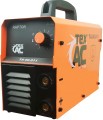Minimum input voltage
The minimum actual input voltage at which the welding machine remains operational.
Such information is useful primarily for working in unstable networks, where the voltage tends to “sag” a lot, as well as from autonomous power sources (for example, generators), which can also produce voltage below the nominal one.
Open circuit voltage
The voltage supplied by the welding machine to the electrodes. As the name suggests, it is measured without load — i.e. when the electrodes are disconnected and no current flows between them. This is due to the fact that at a high current strength characteristic of electric welding, the actual voltage on the electrodes drops sharply, and this does not make it possible to adequately assess the characteristics of the welding machine.
Depending on the characteristics of the machine (see "Type") and the type of work (see "Type of welding"), different open circuit voltages are used. For example, for welding transformers, this parameter is about 45 – 55 V (although there are higher voltage models), for inverters it can reach 90 V, and for semi-automatic MIG / MAG welding, voltages above 40 V are usually not required. Also, the optimal values \u200b\u200bdepend on type of electrodes used. You can find more detailed information in special sources; here we note that the higher the open-circuit voltage, the easier it is usually to strike the arc and the more stable the discharge itself.
Also note that for devices with the VRD function (see "Advanced"), this parameter indicates the standard voltage, without reduction through VRD.
Duty cycle
The duty cycle allowed for the welding machine.
Almost all modern welding machines require breaks in operation — for cooling and general "recovery". The frequency of inclusion indicates what percentage of the time of the total work cycle can be used directly for work. In this case, 10 minutes is usually taken as a standard cycle. Thus, for example, a device with a duty cycle of
30% will be able to work continuously for less than 3 minutes, after which it will need at least 7 minutes of interruption. However, for some models, a cycle of 5 minutes is used; these nuances should be clarified according to the instructions.
In general, high frequency is required mainly for high-volume professional work; with a relatively simple application, this parameter does not play a decisive role, especially since you have to take breaks during work. As for specific values, the mentioned 30% is a very limited figure, typical mainly for entry-level devices. A value of
30 – 50% is also low; in the range of
50 – 70% is the majority of modern devices, and the most "hardy" models provide a frequency
of more than 70%.
Electrode holder cable
The length of the electrode holder cable supplied with the device.
As the name implies, this cable is used to connect the clamp for the welding electrode to the machine. The longer such a wire is, the more freedom the welder has in moving, the farther he can go without moving the machine itself. On the other hand, excessively long cables create problems in storage and transportation, and often during operation (you need to look for a place where to place the excess wire). Therefore, when choosing, you should proceed from what is more important for you: the ability to move away from the device or the overall compactness. As for specific numbers, most often the length of this wire varies from 2 to 3 m, but in some models it can reach 5 m.
Mass cable
The length of the ground cable supplied with the machine.
The mass cable is a wire that is connected to the workpiece with a clamp. In other words, this is the second contact required to close the circuit during electric welding; connecting such a wire actually turns the workpiece into one solid fixed electrode (paired with a movable welding electrode). As for the length of such a wire, the longer it is, the farther from the connection point you can place the machine and the more freedom of movement the welder gets. On the other hand, excessively long wires create problems in storage and transportation, and often during work (you need to look for a place where to place the excess cable). In addition, freedom of movement can be ensured by increasing the length of the second wire — for the electrode holder or burner. Thus, the mass cable in modern welding machines usually has a length of 1.2 to 3 m (with some exceptions — both smaller and larger). This length allows you to comfortably place the device and at the same time does not create problems.

